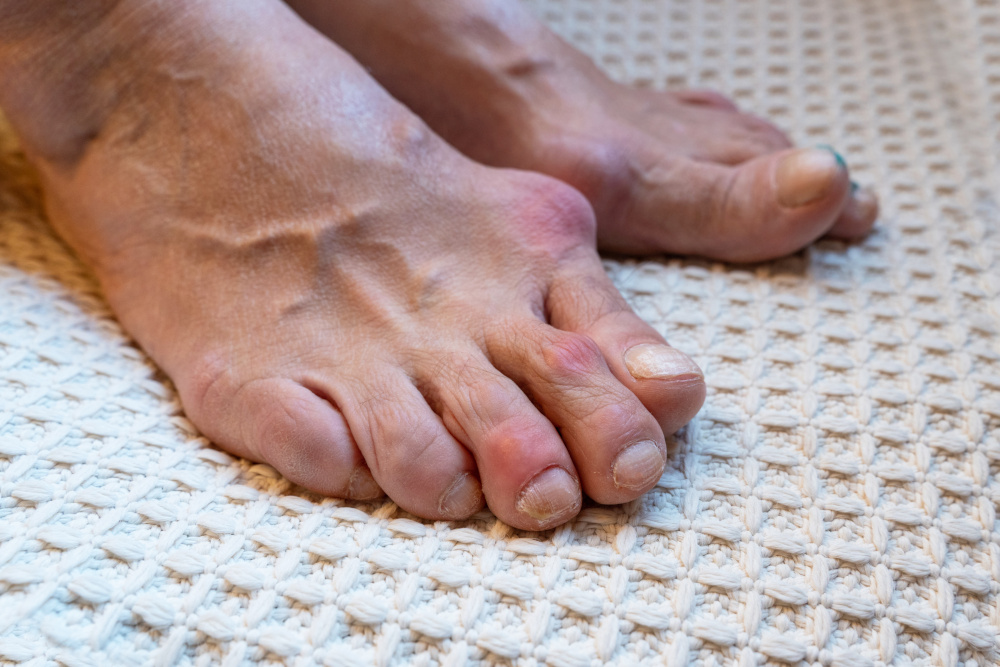Are you living with the discomfort of what you believe to be bunions? If so, have you been searching for a ‘podiatrist near me’ who can help? We have you covered at Beyond Podiatry. Make an appointment at any one of our branches as soon as you can. Bunions are something we see in our clinics on a regular basis.
Bunions are considered a common foot deformity. A person is more likely to experience a bunion deformity with age. In fact, a 2011 study of older patients over 55 years of age showed a bunion prevalence of 36%. The good news is that bunions are very treatable.
What Are Bunions?
Bunions are bony lumps that form at the base of the big toe. As they grow, they begin pushing the big toe inward. As the tip of the toe moves closer to the neighboring toe, it creates a structural issue that results in the formation of a bump. The metatarsophalangeal joint also tends to become misaligned.
What Causes Bunions?
Ask a podiatrist what causes bunions, and you are likely to get a variety of answers. Unfortunately, a single cause has not been associated with the condition. We do know of several factors that can contribute to bunion development:
- Genetics (bunions can run in families).
- Injuries and trauma to the feet.
- Tight or poorly fitting shoes that put undue pressure on the toes.
- Certain health conditions, like rheumatoid arthritis and gout.
It is believed that certain foot types are also more susceptible to bunions than others. For example, flat feet create a structural problem that could contribute to or exacerbate bunions.
What Are the Symptoms?
In addition to the visual appearance bunions create, there are certain conditions to look for. Here they are:
- A bony bump felt at the base of the big toe.
- Pain and soreness that tends to worsen when wearing shoes.
- Redness and swelling in the joint of the big toe.
- Corns or calluses developing where toes make contact.
- Reduced flexibility and movement in the big toe.
For a lot of podiatry patients, the bunion symptom that brings them in for treatment is pain. Sizeable bunions can make wearing even the most loose-fitting shoes uncomfortable. Walking can be a painful experience as well. But again, bunions are very treatable with podiatry.
Diagnosis and Treatment
A foot doctor will usually diagnose bunions after a physical examination and imaging. A physical examination allows the doctor to assess bunion size and location. Medical imaging, by way of X-ray, can show the doctor any potential joint damage and misalignment of the bones.
Surgical treatments are possible, but podiatrists prefer trying nonsurgical treatments first. These include:
- Loose-fitting footwear that reduces pressure on the toes.
- Cushioning the bunion and keeping toes separated with the use of spacers.
- Relieving pain and inflammation with NSAIDs and cortisone injections.
- Orthotic insoles to distribute pressure more evenly.
- Physical therapy that focuses on foot mechanics and pain reduction.
When nonsurgical treatments fail to offer the desired relief, a surgical procedure might be recommended. Bunionectomy involves surgical removal of the bunion while osteotomy involves surgically realigning the bone in the toe.
Bunions don’t have to be painful, but they often are. If you’re experiencing bunions in one or both feet, we invite you to make an appointment to see one of our podiatrists. As foot specialists, our doctors have plenty of experience of treating bunions.
We can help you begin to feel better and take your life back. Just remember that bunions don’t have to be a determining factor in how you’re going to live.

